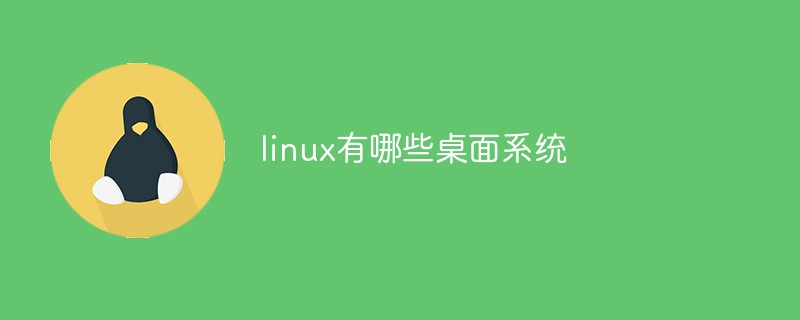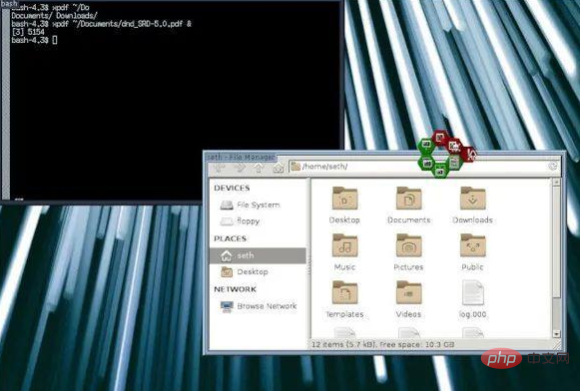 Operation and Maintenance
Operation and Maintenance
 Linux Operation and Maintenance
Linux Operation and Maintenance
 What desktop systems are there for linux?
What desktop systems are there for linux?
What desktop systems are there for linux?
Linux desktops include: GNOME, KDE, Pantheon, XFCE, Cinnamon, Mate, Budgie, Windowmaker, Enlightenment, Fluxbox, Openbox, TWM, FVWM, PekWM, JWM, Rox, etc.

#The operating environment of this tutorial: linux5.9.8 system, Dell G3 computer.
One of the great advantages of the Linux desktop is the choice it provides users. If you don't like the apps menu at the bottom left of the screen, you can move it. If you don't like the way a file manager organizes your documents, you can use another file manager. However, there's no denying that this can be confusing for new users who aren't used to how to use a computer. If you're considering installing Linux, one of the choices you'll have to make is which desktop to use, and the best way is to try a few different desktops until you find the Linux desktop that works for you.
Default Linux Desktop
As the default for Fedora, Ubuntu, Debian and several other operating systems, the GNOME desktop may be the best choice on Linux Most popular desktop. It's an intuitive and modern interface with few mobile design requirements, so it feels natural even on a touch screen. However, some Linux distributions opt for something different, including KDE Plasma, Pantheon, Cinnamon, and Mate.

GNOME: Modern and intuitive default settings
Mate: Traditional GNOME
KDE: The Powerful and Configurable Plasma Desktop
Cinnamon: Classic GNOME
Pantheon: The Divine of ElementaryOS Default
Budgie: Soft Desktop
Trinity: Old KDE
Traditional Unix Desktop
Unix, the origin of modern operating systems and the direct inspiration for Linux, has a surprisingly rich desktop history. Most people are not familiar with Unix desktop design because Unix computers were considered for academic, scientific, and film environments rather than general-purpose professional machines for the home. If you're a Unix, IRIX, or NeXT user, you probably remember desktop programs like CDE or NeXTStep. You're in luck, because these traditional desktops still exist.

Windowmaker: NeXT interface reborn
Enlightenment: An improved Windowmaker style desktop
Fluxbox: Think outside the box
Openbox: Improve the usability of the box
TWM: Bundled with X11 The Timeless Example Desktop
Fvwm: TWM Improved Desktop
The Lightweight Desktop
You may be wondering why there are so many desktop options for Linux. Although you can do a lot of optimization based on personal preference and low tolerance for inefficiency, there are technical advantages to optimizing the interface. For example, older computers are struggling to keep up with updates to their UI [which can be given new life] and lightweight desktops. Alternatively, you might want to allocate CPU cycles only to everything except the desktop, so it makes sense to keep the main UI minimal. Whatever your reason, here are a few things you can try.

XFCE: A familiar desktop at a fraction of the cost
LXQT and LXDE: A familiar desktop Desktop for a fraction of the cost
PekWM: Box Window Manager
Joe's Window Manager: Another Box Window Manager Herbstluftwm: Poison for Vim users
Lumina: Desktop developed for PC-BSD
- Experimental Desktop Desktop
- In the desktop creation and integration One of the things that happens when it's relatively easy to get into a system is that you get interesting proof-of-concept and experimental projects. Some are more polished than others and some are not easy to install. These may not be destined to become your permanent desktop, but they can be fun to experiment with.
Unix Desktop Environment: The Reinvention of the Desktop
 Rox: Today’s Progressive Modern Desktop
Rox: Today’s Progressive Modern Desktop
MLVWM: What if the Apple IIe ran Unix?
Equinox: Just the Basics
- Summary
GNOMEPlasma Desktop (KDE)
Pantheon
-
XFCE
Cinnamon
Mate
- ##Trinity (TDE)
- Budgie
Windowmaker
Enlightenment
- ##Fluxbox
- Openbox
- TWM
- FVWM
- Lx{QT,DE}
- PekWM
- JWM
- Ratpoison
- HerbsluftWM
- Lumina ##UDE
- Rox
- Equinox
- Just a TTY and fbdev
- Related recommendations: "
The above is the detailed content of What desktop systems are there for linux?. For more information, please follow other related articles on the PHP Chinese website!

Hot AI Tools

Undresser.AI Undress
AI-powered app for creating realistic nude photos

AI Clothes Remover
Online AI tool for removing clothes from photos.

Undress AI Tool
Undress images for free

Clothoff.io
AI clothes remover

AI Hentai Generator
Generate AI Hentai for free.

Hot Article

Hot Tools

Notepad++7.3.1
Easy-to-use and free code editor

SublimeText3 Chinese version
Chinese version, very easy to use

Zend Studio 13.0.1
Powerful PHP integrated development environment

Dreamweaver CS6
Visual web development tools

SublimeText3 Mac version
God-level code editing software (SublimeText3)

Hot Topics
 1376
1376
 52
52
 How to solve permission issues when using python --version command in Linux terminal?
Apr 02, 2025 am 06:36 AM
How to solve permission issues when using python --version command in Linux terminal?
Apr 02, 2025 am 06:36 AM
Using python in Linux terminal...
 Four ways to implement multithreading in C language
Apr 03, 2025 pm 03:00 PM
Four ways to implement multithreading in C language
Apr 03, 2025 pm 03:00 PM
Multithreading in the language can greatly improve program efficiency. There are four main ways to implement multithreading in C language: Create independent processes: Create multiple independently running processes, each process has its own memory space. Pseudo-multithreading: Create multiple execution streams in a process that share the same memory space and execute alternately. Multi-threaded library: Use multi-threaded libraries such as pthreads to create and manage threads, providing rich thread operation functions. Coroutine: A lightweight multi-threaded implementation that divides tasks into small subtasks and executes them in turn.
 How to open web.xml
Apr 03, 2025 am 06:51 AM
How to open web.xml
Apr 03, 2025 am 06:51 AM
To open a web.xml file, you can use the following methods: Use a text editor (such as Notepad or TextEdit) to edit commands using an integrated development environment (such as Eclipse or NetBeans) (Windows: notepad web.xml; Mac/Linux: open -a TextEdit web.xml)
 Can the Python interpreter be deleted in Linux system?
Apr 02, 2025 am 07:00 AM
Can the Python interpreter be deleted in Linux system?
Apr 02, 2025 am 07:00 AM
Regarding the problem of removing the Python interpreter that comes with Linux systems, many Linux distributions will preinstall the Python interpreter when installed, and it does not use the package manager...
 What is the Linux best used for?
Apr 03, 2025 am 12:11 AM
What is the Linux best used for?
Apr 03, 2025 am 12:11 AM
Linux is best used as server management, embedded systems and desktop environments. 1) In server management, Linux is used to host websites, databases, and applications, providing stability and reliability. 2) In embedded systems, Linux is widely used in smart home and automotive electronic systems because of its flexibility and stability. 3) In the desktop environment, Linux provides rich applications and efficient performance.
 How is Debian Hadoop compatibility
Apr 02, 2025 am 08:42 AM
How is Debian Hadoop compatibility
Apr 02, 2025 am 08:42 AM
DebianLinux is known for its stability and security and is widely used in server, development and desktop environments. While there is currently a lack of official instructions on direct compatibility with Debian and Hadoop, this article will guide you on how to deploy Hadoop on your Debian system. Debian system requirements: Before starting Hadoop configuration, please make sure that your Debian system meets the minimum operating requirements of Hadoop, which includes installing the necessary Java Runtime Environment (JRE) and Hadoop packages. Hadoop deployment steps: Download and unzip Hadoop: Download the Hadoop version you need from the official ApacheHadoop website and solve it
 Is Debian Strings compatible with multiple browsers
Apr 02, 2025 am 08:30 AM
Is Debian Strings compatible with multiple browsers
Apr 02, 2025 am 08:30 AM
"DebianStrings" is not a standard term, and its specific meaning is still unclear. This article cannot directly comment on its browser compatibility. However, if "DebianStrings" refers to a web application running on a Debian system, its browser compatibility depends on the technical architecture of the application itself. Most modern web applications are committed to cross-browser compatibility. This relies on following web standards and using well-compatible front-end technologies (such as HTML, CSS, JavaScript) and back-end technologies (such as PHP, Python, Node.js, etc.). To ensure that the application is compatible with multiple browsers, developers often need to conduct cross-browser testing and use responsiveness
 Do I need to install an Oracle client when connecting to an Oracle database using Go?
Apr 02, 2025 pm 03:48 PM
Do I need to install an Oracle client when connecting to an Oracle database using Go?
Apr 02, 2025 pm 03:48 PM
Do I need to install an Oracle client when connecting to an Oracle database using Go? When developing in Go, connecting to Oracle databases is a common requirement...



